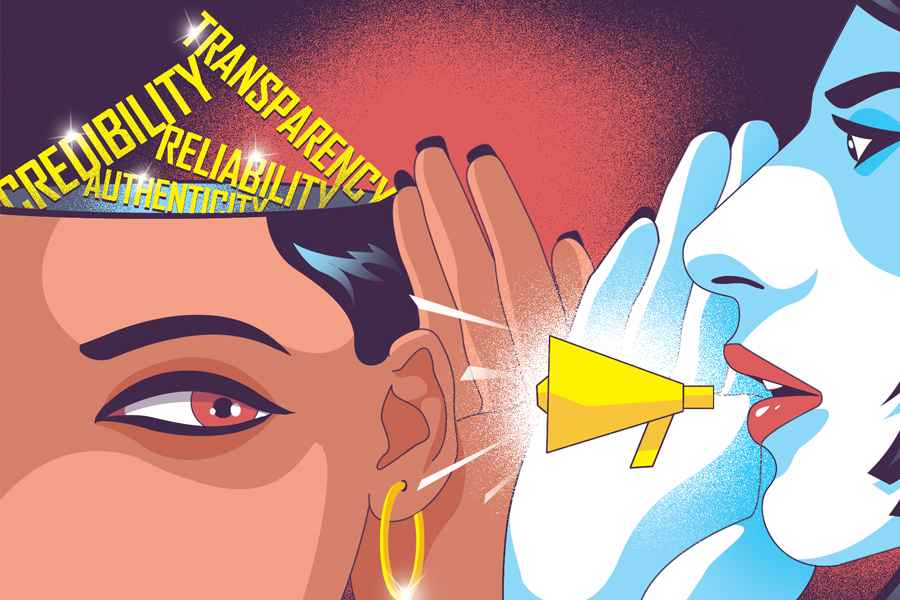Ensuring transparency in AI-powered influencer campaigns is more than a buzzword—it’s our front-line defense against the murky waters of digital marketing. As the mind behind these campaigns, I dig deep into the mechanics that drive AI influencers. Let’s pull back the curtain to reveal how ethics form the backbone of every bot-led endorsement. By laying out clear frameworks and embracing full disclosure, I ensure that every slick, AI-driven campaign you encounter holds up to the highest standards of integrity. Dive in as I break down the complex interplay of regulations, trust, and authenticity. This isn’t just about selling; it’s about sustaining the very credibility of our digital marketplace.
The Importance of Ethical Foundations in AI Influencer Marketing
Establishing a Framework for AI Marketing Ethics
When we talk about AI influencer marketing ethics, we mean the rules we all agree on. These rules keep things fair and right. Imagine playing a game where no one knows the rules. Everything would be a mess, right? So, we make rules that everyone follows. This makes sure that the game is fun and fair for all. Now, think of AI influencer marketing like that game. We need good rules, or ethics, so that everyone plays fair.
These ethics tell us how AI influencers should act. They help us to make sure AI influencers stay true and honest. For example, if an AI influencer is sharing about a toy, we want to know who made them say it’s good. Was it the company that made the toy? This way, we can trust what they say. With these rules, we make sure AI influencers tell us when someone else is asking them to talk about something.
The Role of Transparency and Disclosure in AI-Generated Content
Now, let’s dig into how we keep things clear and open with AI-generated content. Transparency means not hiding anything. Disclosure is when you share everything that others should know. They are like the clear glass on a candy machine. You can see all the goodies inside before you put your coin in.
When an AI influencer talks about something, say a new video game, we want to know if they mean it. Or are they just saying it to make the game sell more? This is why they need to tell us, “Hey, the video game folks asked me to talk about this.” When they do, it’s fair play. We know what’s up, and we can choose to believe them or not. It protects us from being tricked.
In many places, the law helps with this. Groups like the FTC say that AI influencers must be clear about ads. If they don’t, it’s like hiding the candy inside that glass candy machine. No one wants that. So, AI influencers have to tell us when something is an ad. By doing this, they follow the law and make sure our trust in them stays strong. We stay in the know, and that builds a bridge of trust.
With these steps, AI influencers become friends we can trust, not just voices trying to sell us stuff. They share, we listen, and it’s all fair and square. Good ethics bring trust, and trust brings good friends. That’s why we work hard to make sure AI influencer marketing sticks to the rules. By doing this, we’re making the internet a fairer place, one post at a time.
Navigating Regulatory Landscapes: Compliance and Consumer Trust
Understanding Influencer Marketing Regulatory Guidelines
Let’s dive into the rules that guide influencer marketing. You might wonder, “What are these rules?” They’re the must-follow laws for any influencer out there. They keep things fair for buyers like you.
Think of it like a traffic light for ads. It tells influencers when to say “Hey, I got paid for this,” or “I got this product for free.” This way, audience members know what’s an ad and what’s not. Remember, not all influencers are people! Some are made by computers—we call them AI influencers. And yes, they must follow these rules, too.
Implementing FTC Compliance in AI Campaigns
Now, let’s figure out how AI influencers can play nice with these rules. “How can AI influencers stay truthful?” you may ask. One big way is making it clear when something is an ad. All it takes is a simple note like “Sponsored” or “Ad” in their posts.
This note is a nod to honesty. It’s the influencer saying, “Hey, I teamed up with a brand.” It’s super crucial for trust. We want everyone to know the real deal. We don’t want anyone feeling tricked, right? It’s about keeping it real with what you see and read.
So when an AI influencer tells you about the latest, greatest sneaker, check for that little ad note. It’s a small thing, but it’s mighty. It tells you that sneaker company gave them a thumbs-up (and probably some cash) to talk about their kicks.
These rules, by the way, come from the big guys at the FTC—short for the Federal Trade Commission. They’re like the referees in the game of ads. They make sure everyone plays fair, both humans and AI.
With new tech, we’ve got new ways to share info. But, the core of good ads stays the same—honesty. Let’s keep our AI influencers in check and our buyer buddies clued in. It’s good for business, and it’s right for you.
Creating Credible AI Influencer Partnerships
Advocating for Authenticity in AI Influencer Content
As an expert in AI influencer marketing, I stand for real-deal content. I know you value what’s genuine. That’s why it’s key that any post an AI influencer shares rings true. We all want to know, “Is this the real thing or just pretend?” For AI influencer content, we need this same honesty.
So, how do I assure that what an AI shares is straight up real? I lean on clear labels and tell-alls. AI-generated content must say it’s made by AI. You heard right: full disclosure, every time. Think of them like nutrition facts but for posts online. By law, any AI post must show it’s an ad, loud and clear. This makes sure you can trust what you see and know what’s up.
Setting Transparency Standards for AI Endorsements
Okay, but what does full-on transparency mean for AI shout-outs? It means standards. Clear rules that tell how to share AI posts right. I work to set the bar high for transparency. This helps businesses play fair and stay true. When AI influencers back products, they should never mislead.
For AI-driven deals to be cool, two things need to happen. First, any AI posts must point out they’re sponsored. This is not just nice to have, it’s a must. Second, they need to be honest about who made them. This info has to be out front, not hidden.
Tech tools help manage this honesty. They can track posts and say if they meet the mark. It’s like a trust-check for AI shout-outs. These tools make sure businesses stick to the strict code. They also help you know what’s real and what’s ad-talk.
In short, every move in AI influencer marketing has to be transparent. This way, everyone knows the score. You deserve to know when you’re seeing an ad, who’s behind it, and if AI had a hand in it. The goal? To keep things clear and keep trust strong. That’s how we roll with AI. That’s how we secure a spot for AI in the marketing world. A place built on respect, honesty, and the straight talk everyone deserves.
Measuring the Impact of AI Influence on Consumer Behavior and Brand Image
Analyzing AI-Driven Influencer Strategies
To grasp how AI affects what people buy, we must dig deep. We see AI influencers everywhere online. They might look real, but computers make them. They talk about products, just like human influencers do. Can they change your mind about what to buy? Yes, in fact, they often do. Understanding this can help businesses a lot.
Here’s how we see it work: AI influencers like Lil Miquela post about new sneakers on Instagram. People see Miquela’s posts and think, “Wow, those are cool!” But there’s more to it. When AI shows these posts, it knows who will like them. It understands you based on what you click online. So when Miquela shows you sneakers, it’s because AI thinks you’ll want to buy them.
But how do we know if it really works? That’s where data comes in. Businesses look at things like how many people liked or shared a post. They also see if people talked about the brand more after an AI influencer post. By looking at numbers, they learn how well AI changes what people think about a brand.
Transparency is key here. When AI influencers are used, people should know. It’s about trust. We all want to make sure what we see online is honest. So, companies must say clearly when a post is from an AI.
Now, let’s talk brand image. AI can help make brands look good or bad. If a brand uses AI the right way, people might see them as cool and high-tech. But, get this wrong, and people could lose trust in the brand. Nobody wants that. That’s why keeping things clear and honest is so important.
Assessing Accountability in AI Influencer Collaborations
Accountability is a big word for a simple thing: doing what’s right and owning up to it. With AI influencers, brands have to be careful. They need to follow rules and respect their customers’ trust. If they slip up, they should make it right.
Say an AI influencer doesn’t tell you they’re AI. People might feel tricked when they find out. That’s a no-go. The brand behind them should fix that fast. They should say sorry and make sure it doesn’t happen again.
What’s more, laws like the FTC’s rules are in play here. They say you have to be clear when posts are ads. This is true for AI influencers, too. Brands that team up with them should make sure this is always done right. It keeps customers informed and helps them trust the brand.
Wrapping up, it’s not just about selling stuff. It’s about creating lasting, honest relationships with customers. That means using AI influencers in the right way. Being open about what’s an ad and what’s not. And always keeping an eye on how these AI pals shape the thoughts and feelings people have about brands.
In this post, we dug deep into the ethical ground rules of AI in influencer marketing. We kicked off by setting up a moral frame for AI ethics. Next, we tackled the tough stuff—staying clear and honest in content made by AI. We then steered through tricky legal waters, showing you how to keep trust with the rules and your audience. I stressed how realness in AI influencer content and clear standards make for strong partnerships. Lastly, we looked at AI’s pull on folks and brands, weighing up the smart moves and the need for owning actions.
My final thought? Ethical AI influencer marketing isn’t just nice to have—it’s a must. When we do it right, it keeps trust and respect in the game. It’s all about staying true, clear, and on the level, every step of the way.
Q&A :
How do we ensure transparency in AI-powered influencer campaigns?
Ensuring transparency in AI-powered influencer campaigns requires clear communication of the use of AI tools in the selection process of influencers and the content creation. This could involve disclosing the AI’s role in campaign analytics and decision-making, and ensuring influencers are transparent about any AI-generated content they share. It’s also vital to comply with guidelines and regulations that demand disclosure of AI involvement to maintain trust amongst consumers.
What are the best practices for maintaining transparency in influencer campaigns with AI?
Adopting best practices for transparency in influencer campaigns with AI includes openly disclosing the usage of AI technologies and their impact on content. Influencers should clearly label content that’s been created or modified by AI, while brands should educate their audiences on how AI contributes to the personalization of the content they see. It’s also essential to uphold ethical standards and respect privacy when using AI analytics for targeted advertising.
How can consumers distinguish between AI-powered and purely influencer-created content?
Consumers can distinguish between AI-powered and purely influencer-created content through clear labeling and disclosure. Influencers and brands should provide disclaimers or use specific tags when publishing content that has been produced or augmented by AI. Increased consumer awareness and education regarding AI’s role in content creation can also help in making this distinction clearer.
What are the regulatory requirements for AI-powered influencer campaigns?
Regulatory requirements for AI-powered influencer campaigns typically revolve around transparency and disclosure. This could include obligations to mark content clearly when AI has played a significant role in either selecting influencers or directing content creation. The Federal Trade Commission (FTC) and similar regulatory bodies in other jurisdictions often mandate that consumers must be made aware of any promotional content, including those driven by sophisticated AI algorithms.
How can AI influence the authenticity of influencer marketing?
AI can influence the authenticity of influencer marketing by providing data-driven insights that help match brands with influencers whose followers best align with the brand’s target audience. However, if not used transparently, AI can lead to questions about the genuineness of influencer endorsements. Transparency in utilizing AI helps maintain the trust that is the cornerstone of authenticity in influencer marketing. It’s crucial for brands to balance the efficiency of AI with genuine human engagement to keep influencer content authentic.






